A few years ago I heard on the native grapevine that a Long-nosed Potoroo (Potorous tridactylus) had been taken into care by wildlife carers near Maleny. The story goes that a Reesville resident was investigating a noise outside their house when they came across a sizeable Carpet Python with a visibly large bulge somewhere between its throat and belly. Another noise was heard nearby and a very small (120 grams) marsupial was found. Unfortunately its mother was probably the ’bulge’, but it had managed to escape. This lucky potoroo joey was named ‘Luke’ and was lovingly cared for and raised (until release) by Land for Wildlife members and wildlife carers, Carmel Givens and Ridley Kennedy.
The Long-nosed Potoroo is one of the smaller members of the kangaroo family. They are just over a foot long and weigh just over one kilogram. This is a rare and cryptic species that seldom ventures from the shelter of dense understory vegetation. They have a patchy distribution along the east coast of Australia. Chance sightings are very rare and are usually restricted to a hopping blur dashing across the road in front of a car at night.
Listed under Commonwealth legislation as vulnerable to extinction, the Long-nosed Potoroo is known to live in a wide variety of habitats from coastal heath to rainforest and in both wet and dry sclerophyll forests. The commonality in their distribution is the presence of a thick understorey. Potoroos create runways through the dense undergrowth allowing them to move quickly and escape potential predators.
Like bandicoots, potoroos leave feeding evidence in the form of diggings where they excavate roots and underground fruiting bodies of fungi. Studies in Victoria have shown that fungi can form up to 70% of a potoroo’s diet. We can only assume that this is the same in Queensland, but we really don’t know. The subsequent dispersal of fungal spores in potoroo droppings is an important ecological process, as some of these mycorrhizal fungi assist plants in the uptake of otherwise inaccessible nutrients from the soil. In effect, potoroos help keep forests healthy and probably ensure more ecological benefits than we currently know.
There are precious few records of potoroos from Queensland, so the discovery of Luke was a very exciting find indeed. For me, the questions raised by Luke’s discovery were many. How large was this potoroo population and how wide spread? Was Lukey the last link in a lineage of truffle- seeking local long-noses? What would their absence mean for these forests? Little research has been done on Queensland potoroos and many questions remain unanswered.
“In effect, potoroos help keep forests healthy”
I had long wondered about the presence of potoroos on the Blackall Range. Despite recent records from nearby Bellthorpe and Conondale Ranges, they hadn’t been recorded in the Blackall Range area, despite the apparent presence of suitable habitat. Reesville lies at the southern end of the Maleny plateau and incorporates a relatively large tract of forested country on the steeper slopes of the Blackall Ranges western escarpment. There are no National Parks or reserves in this area. All the bushland is privately owned and Land for Wildlife signs are a common sight along the handful of no-through roads that dissect the heavily vegetated area.
If potoroos around Maleny avoided detection for the past 150 years, what else is out there?
In 2008, Sunshine Coast Council funded survey work to search for potoroos, and at the time I suggested surveying Liz and Kel Harding’s Land for Wildlife property next door to where Luke happened to be found several years later. Disappointingly, the survey found no evidence of potoroos reporting that “Despite approximately 1500 hair-trap nights and a combined total of 11 areas surveyed during this and a previous survey (Burnett et al. 2007), potoroos remain missing on the Sunshine Coast”.
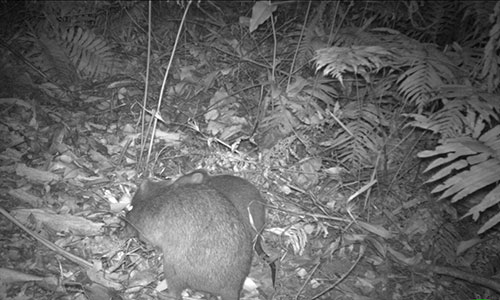
These two images show a family of Long- nosed Potoroos captured by motion-sensor cameras on a Land for Wildlife property at Reesville. Note the thick, dark tail in the left hand image.
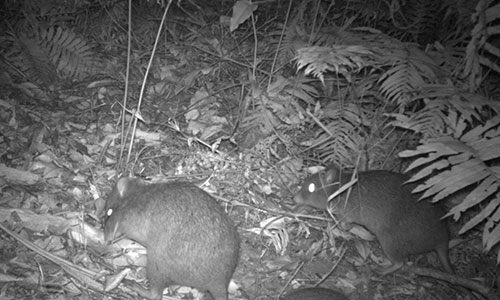
The same family of Long-nosed Potoroos as shown on facing page, captured again using Reconyx motion sensor cameras. Potoroos move in a similar way to kangaroos – they either hop on their hind legs (far right image) or they use their front legs for support and slowly bring their hind legs through.
Inspired by Lukey, supported by local landholders, and armed with the latest fauna detection camera technology, my colleague Alan Wynn and I started deploying cameras on Land for Wildlife properties in the Reesville area. The results weren’t immediate but we persisted, and in doing so we experimented with different motion sensor camera brands. When we changed to the more sensitive Reconyx cameras, we were delighted to capture images of potoroos on Liz and Kel’s property.
Liz and Kel joined Land for Wildlife in 1999 and finding potoroos on their land has made their many years of hard work and custodianship even more rewarding. Buoyed by this success, we expanded our search efforts onto another five neighbouring Land for Wildlife properties, collecting more potoroo records on three of them. It is interesting to note that all of the potoroo properties have dense understory vegetation such as true and soft bracken ferns.
Once we had a selection of sufficient potoroos photographs we decided to hold a slide show for local landholders. In February 2015 a get-together was organised for Land for Wildlife members in the area as well as any other interested local landholders. Besides potoroos we had captured hundreds of images of other critters. The slide show included images of Brush Turkeys, other birds, reptiles, mammals, more Brush Turkeys and of course potoroos. It was an opportunity for landholders to get to know this cryptic species, which also calls this area home. The local Land for Wildlife membership also grew by another three properties due to this event.
Participants at the slide show were also encouraged to include their properties in a Sunshine Coast University Masters Research project that has been developed in response to this potoroo discovery. The Masters student will be working closely with local mammal expert, Dr Scott Burnett, who has been involved in previous potoroo survey efforts on the Sunshine Coast. The research project will focus on the habitat requirements for this cryptic species and will hopefully fill some of the knowledge gaps.
A follow up event will be held for landholders once the research project has some findings to share.
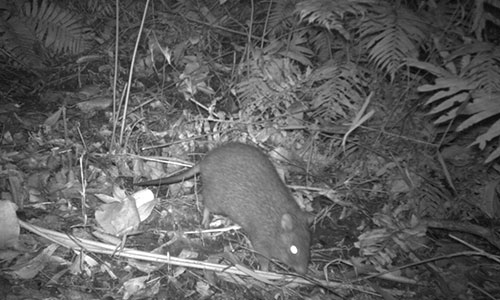
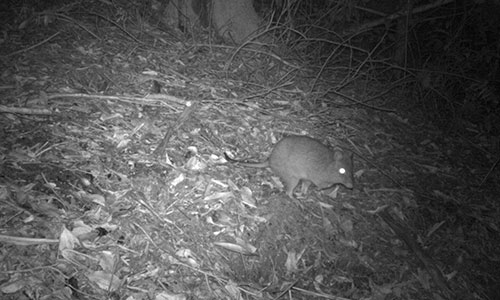
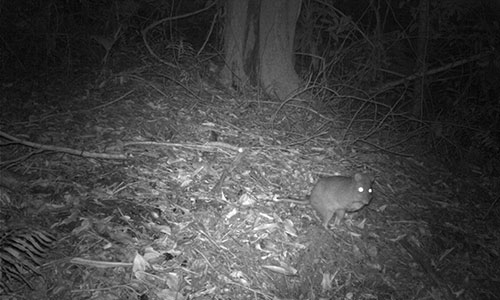
Participants also took home a kit with gloves and bags and were encouraged to collect any fox or dog scats they find on their properties. In an attempt to better understand the threats to the local potoroo population, scats will be analysed to determine if these predators are preying on potoroos. There are wild dogs in the vicinity and Sunshine Coast Council undertakes baiting in the broader area. There are also foxes in the area, although based on the camera surveys to date, their numbers do not appear to be high. It will be good to gain a better understanding of the interplay between predators and prey to help inform future management.
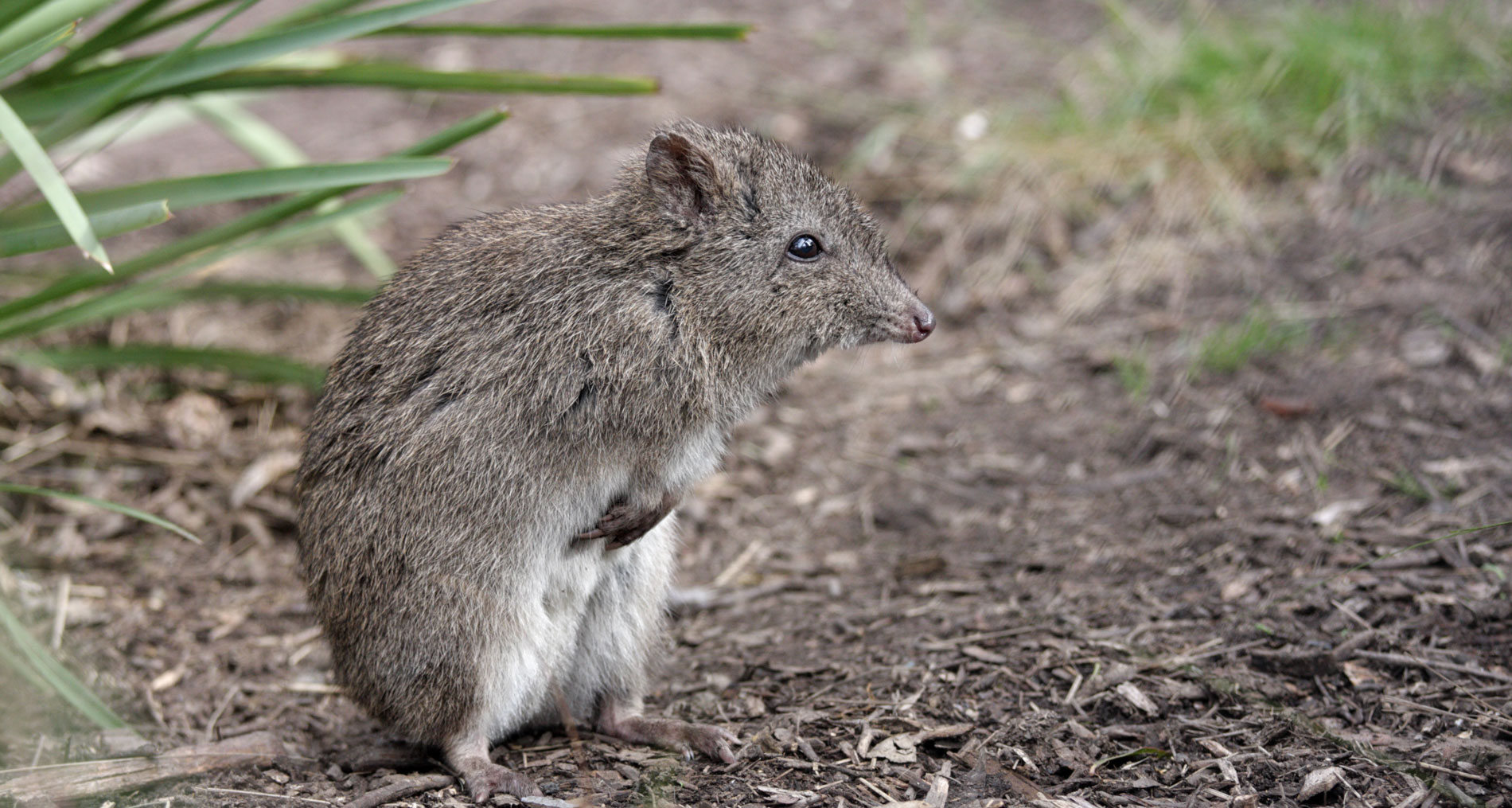
This Long-nosed Potoroo is part of a captive breeding program. Note its strong digging claws and its kangaroo-like hind legs. Photo by Leo Berzins (Oystercatcher), Flickr CC BY-NC-SA 2.0.
Two things really excite me about this discovery so far. Firstly is the untapped opportunity available through the use of unobtrusive motion sensor cameras on Land for Wildlife properties and the potential for other discoveries. If potoroos around Maleny avoided detection for the past 150 years, what else is out there? And finally, this demonstrates how Land for Wildlife can play a central role in creating networks of landholders, governments and researchers to raise awareness and act locally to protect threatened species.
Article by Nick Clancy Land for Wildlife Officer Sunshine Coast Council

Hi I have seen these Potoroos at my property in. North Maleny ( we are close to Maleny we have 2.5 acres mix of dense bush and open grass paddocks, we are wild life lovers and we support them.)
I thought it was a bandicoot but it hopped away have seen plenty of bandicoots this creature was bigger and hopped.
Also I am concerned for the brush Turkeys we had lots of them as Xmas 2019 came closer the turkeys became less and Less know there is none. There is plenty of food for them at our property we set up water trays for the drought they used them and now their gone I hope people in the area are not taking things into their own hands and taking them away or killing them as we know they dig up,gardens. ( turkeys are good for the bush they have been in the forests for thousands of years )
Hi Stephen. Thanks for this reporting. We have sent you an email as a follow up.
Hi We live at Montville, and we are sure we have Potoroos on our 10 acre property. My husband has seen them run away, the holes they dig, and unfortunately one the other day which had been run over on Main Street outside our place.
Hi Larraine. Thanks for reporting this sighting. We will follow up with an email.
Hi,
We have been on our property which backs onto Racemosa Conservation park (Landsborough) since November. We have spotted what we think is a Long nosed Potoroos 3 times – once being a mother and juvenile. All 3 times they took off on their back legs. We thought it was bandicoots until my sister ( an experienced Ranger) pointed out the fact that bandicoots don’t stand on back legs. Also we had the pleasure of watching a squirrel glider across our dam for 5 minutes at dusk. I saw in the Racemosa Management papers that it had not been identified as living in Racemisa – it does. Just want these 2 amazing creatures to be identified as living in Racemosa for future protection.
Hi,
We have spotted at potoroo on our property in Eumundi, Qld. I’ve seen it 3 nights this past week and I managed to get a photo and short video of it too ☺️
Hi Elyce. That is great. We will contact you via email to follow up. Thanks!
Hi Elyce, In addition, you may wish to post your sightings on iNaturalist https://www.inaturalist.org/ or Atlas of Living Australia https://www.ala.org.au/.
How do I upload photos or videos of a mammal,in our back yard
Hi Jason. If you want a mammal identified you can upload photos/videos to the Qld Museum Ask An Expert page https://www.museum.qld.gov.au/learn-and-discover/ask-an-expert
or there is the Australian Mammal ID page on Facebook
https://www.facebook.com/groups/MammalIDAus/
I’m another land for wildlife property owner in Reesville. I’d like to be involved in the potoroo detection group and invite anyone interested to use my property for sensor cameras. I’ve only just found the attached article and I too am sure they’ve been here for over 20 yrs which the time of my ownership if this riparian rainforest. I’m an avid birdwatcher so mainly concentrated ID effort of birds. I’m keen to learn more about other rare, vulnerable and endangered wildlife here. We have koalas, platypus etc here also.
Hi Lara, I’m a local Wildlife Scientist to Moreton Bay Region. I work with a conservation detection dog, currently trained to find feral cats and koala scat, and in training for long nosed potoroo scat. I would love to utilise your property to further train my dog and confirm if these animals are present.
I lived beside Geraughty Creek /Doyle Road often wondered about Potoroos we had Pademelons and bandicoots but two or three times something shot across the track so fast I couldn’t be sure if it was a Potoroo. I didn’t know about these other sightings. I lived there from 1980 for 23 years. I did Nature Search. Regards Ann Peach